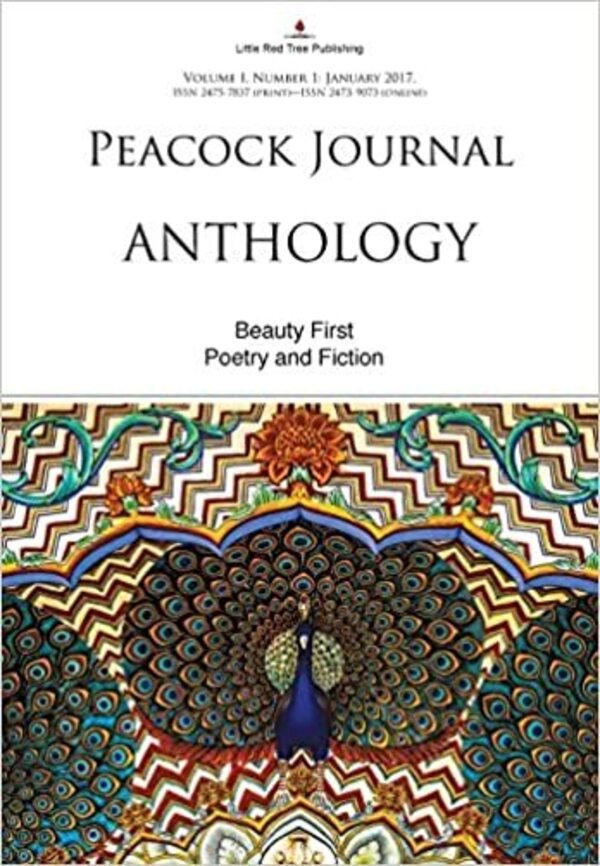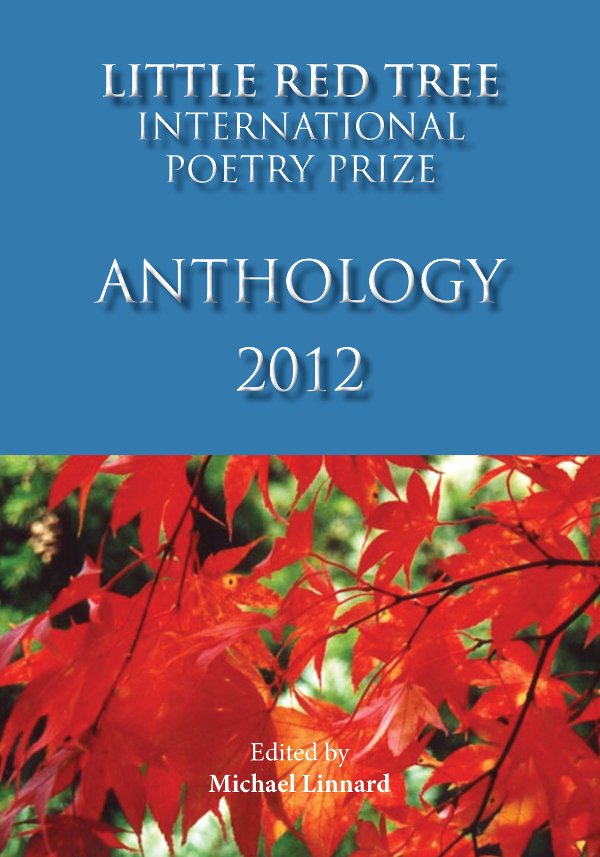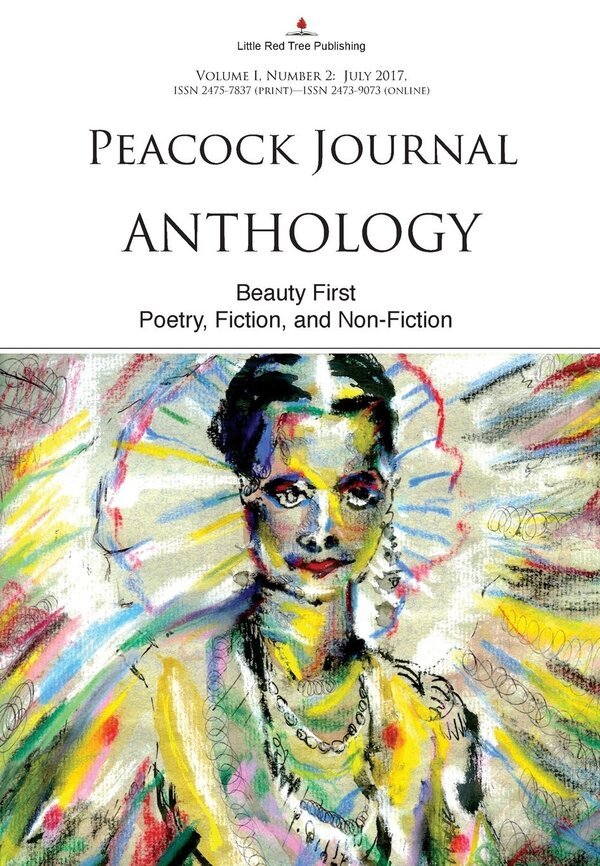Peacock Journal – Anthology: Beauty First [Volume I, Number 1]
Edited by W.F Lantry
($9.95. (7 & 10), Paperback, 108 pages)
CONTRIBUTORS—POEMS AND FICTION
POETRY
Maryann Corbe : “Disquiet”
Mary Jane White : “Letheís underwater light…”
Janet Bowda : “Men in the Abstract”
Aaron Poochigian : “A Memory, Perhaps”
Corey Mesle : “Eucalyptus, I Calyptus, We all Calyptus”
William Doreski : “Not Drawing Your Portrait”
Christine Potter : “Zion Episcopal Church, 1962″
Jeff Hardin : “Coming Into An Inheritance”
Rachel Dacus : “Reaching the Apogee on an August Midnight”
Alfred Corn : “Peahen”
Catherine Arra : “The End of Night”
Tobi Alfier : “Madalena Castillo at the Feria de Sevilla”
Britny Cordera : “Musings of a Unicorn”
Kathleen Kirk : “Date with the Rain”
Sandra Kohler : “Equinoctal”
Uche Ogbuji : “Mysteries of Harvest V”
Nadia Ibrashi : “Rapture”
Diana Raab : “Venus Fly Trap”
John Casquarelli : “From Havana Dialogue”
Julieta Fuentes Roll : “Departure”
John Francis Istel : “Leaves of Words”
Jonel Abellanosa : “Otherness”
Hedy Habra : “Deeper Than Tattoo”
Julie Kane : “Pink Magnolia”
Lana Bella : “I Dreamed Where the Blue Siloed”
Allison Grayhurst : “Sacred Beginnings”
Milla van der Have : “We Lay Our Alms at Aamos Kirk”
Clarence Major : “Aesthetic Debt”
Sneha Subramanian Kanta : “Last Autumn”
Michael T. Young : “A Savor of Stars”
Soodabeh Saeidnia : “For My Son’s Birthday in Kyoto 2006”
Paul Ilechko : “Her Seasons”
Carolyn Martin : “Migration”
DeWitt Clinton : “In a Waiting Room…”
Ailish Woollett : “Morphology I.”
George Held : “The Ache of Fall”
Karlo Sevilla : “Late Afternoon at the Fish Pond”
Jean-Yves Solinga : “Great Blue Heron in Paris”
Angelina Saule : Heartography”
Ruth Asch : “Willow”
Danielle Hanson : “Love Song”
Annie Stenzel : “Seasoned”
Harry Youtt : “Sometimes a Tall And Slender Palm”
Jose Sotolongo : “Winter Leaves”
Jennifer Lunden : “We Have Moths in the Pantry”
Michael Ratcliffe : “Contemplating the Grasshopper That Landed on My Knee …”
Kim Bridgford : “Why Sisyphus Isn’t a Woman”
John C. Mannone : “Butterfly Wings”
Jesse Glass : “Picture Postcard (1916)”
Tricia Knoll : “She Who Knits in the Buddhist Monastery”
Sanjeev Sethi : “Magnificent”
Tikuli : “Home”
Sergio Ortiz : “If Ulysses Should Die on a Tuesday”
Samara Golabuk : “Lie still”
Sarah Sadie : “Bachelard Writes of Houses, Bachelard Writes of Miniatures”
FICTION
Susan Tepper : “Uneven Like Islands”
Susan Nordmark : “Blue”
Lana Elizabeth Gabris : “Descent Ascent”
Kirsten Milligan : “Rare Specimens”
Martin Golan : “The End of Tina”
Paul Beckman : “Splinters”
Kelly Cherry : “Murray, the Short Order Cook”
Kris Faatz : “Night Roses”
Norman Klein : “Mysteries”
Toti O’Brien : “The Candidate 84”
INTRODUCTION
I don’t know much. But I can tell you the exact moment when it happened. It was around ten-fifteen on a Thursday morning in September. The 19th, as I recall. Kate and I were heading South on Route 29 rolling towards the Beltway. We’d just crossed the bridge over the Northwest Branch of the Anacostia River. And as we started up the hill, Kate turned to me and said:
“You should start a journal.”
Now, I’m no stranger to journals. I started one back in California. And I can’t even count how many times I’ve been faculty advisor to a literary journal or nurtured one along in an unofficial capacity. I’ve even provided secret web space for one when the university administration shut it down. So as soon as she spoke, I saw the whole scene at once.
But in spite of all that, when we got home, I posted a web query: “Should we start a journal?” The response was overwhelming. Many colleagues gave advice and encouragement. Some flat out said, “No, you’ll go crazy.” A bunch of folks talked about money, time, and stress. Others saw an opportunity. It soon became clear most of the answers reflected the respondents’ own experience and proclivities. But Maryann asked the most important question:
“Why?”
The ensuing months were devoted to family issues and my own writing. So many things happened. All that time I kept Maryann’s question in my head, in spite of the whirlwind. Then, in the Spring, we were having dinner with a colleague. He waited until I’d had a couple of Margaritas, then asked “What are you doing with the journal?”
“Too much to think about,” I said. “I’d have to register a domain name, get some webspace, acquire a WordPress theme…”
“I’ll do all that,” he said, “you just think about the journal.”
He did, I did. I thought and thought and thought… and thought about it. Spring turned into Summer, and Winter brought the largest blizzard DC had ever seen. I just wanted to fly South. And I still wanted to fly South when Spring rolled around again. Then Kate said “William, the domain name is about to expire. Get to work.”
OK. But there was no way we were going to pay for a submission manager. I coded one instead, tweaking some plugins to do what I wanted. The delay had allowed technology to catch up to my ideas, and there was a brand new theme to help with the layout. It was intended for daily newspapers and had an integrated database. I figured out how to make everything work together, and set up both test and production sites. But the technology is always the easy part.
Why? What was our focus? How were we different from all those other journals? What problems could we solve?
You know what’s the worst? When you write something and get it accepted, and then it takes three years for it to appear! Second worst? When you write something, send it off, and wait months for an editor to reject it. Third worst? When something finally gets accepted and published, but the format is so unseemly you don’t even want to tell anyone about it. Fourth worst…
So yes, there were problems to solve. And other things as well. I’ve always had a strong interest in aesthetics, and I’ve always been frustrated when I’ve asked others, ‘What are you up to with your work?’ and they’re reluctant to articulate their aesthetics. I came up with a tagline: Beauty First. And I thought about the VIDA numbers. About the doubts emerging writers have. And about the experience we wanted for readers.
So it was June, and I was at a writer’s conference, sitting way in the back, coding on a laptop. Really, everything was ready, and there was no reason not to move forward. Then I heard the speaker say, “Most web journals don’t take advantage of the technology.” So I said, under my breath, Oh yeah, Quincy? Watch this! And before he was done speaking, I pressed the send button on our call for submissions.
Then we promptly left for Panama for a month, and everything seemed so far away. We didn’t have much net access. We came home to a flooded email box. “William,” Kate said, “you need to pick an auspicious day for launch.”
So I did: Monday, August 15th. A sacred day for her. And we moved forward together.
There’s so much more to the story: the sudden success, tens of thousands of readers from well over sixty countries, more than two hundred fifty contributors published. But two things really stand out. First, early on, after I’d included an ‘Artist’s Statement’ to some photos of an artist’s paintings we published, Kate said, “You know, we should ask the writers for a statement on beauty. Nobody ever does that. People might jump at the chance.” So we did. That really opened the floodgates. It’s fascinating to hear what people say when they have a space to discuss art, beauty and aesthetics.
Another thing happened early on: an old colleague sent a couple images along with his poems. And he had some quotes, and some references embedded in the work. And I thought we could do more than simply have a text reference to Charles Aznavour singing a song. We could include a video of him. Instead of just mentioning Julie, ou la nouvelle Héloïse, we could include a contemporary 18th-century image. And since he’d said he was listening to a certain jazz musician while he was composing the poems, we could even include a recording of that so the viewer could read the poems in the same mindset the author was in while composing them.
Yes, it took a little extra work (a little!). But it was worth it. When he saw the result, he could barely believe it. Here’s what he wrote to Kate: “I am deeply touched by the result. Reading (and listening) to my words is not short of ‘religious’: which is quite a step for a confirmed absurdist soul like mine. I feel as though I have finally found the artistic validation searched for by artists.”
So that’s the answer to the ‘Why?’ question. We’re trying to treat people’s work with the respect it deserves. The respect they deserve. Which doesn’t always happen in the literary world. But we believe it should. And we believe there should be a place to go, a place of beauty and artistic peace. And people have responded.
One last thing. Why a peacock? I’ll tell you a secret. The peacock is Kate’s favorite animal. We have three or four images of peacocks in our home—although you wouldn’t notice them if you didn’t know. On one of our first outings, she took me to Whistler’s Peacock Room, so it’s a fond memory. The peacock holds a strong position in world literature and art. And there’s another reason, one which I’ll keep hidden. You’ll figure it out soon enough…
W.F. Lantry
Washington, DC 2017





Hi, this is a comment.
To get started with moderating, editing, and deleting comments, please visit the Comments screen in the dashboard.
Commenter avatars come from Gravatar.